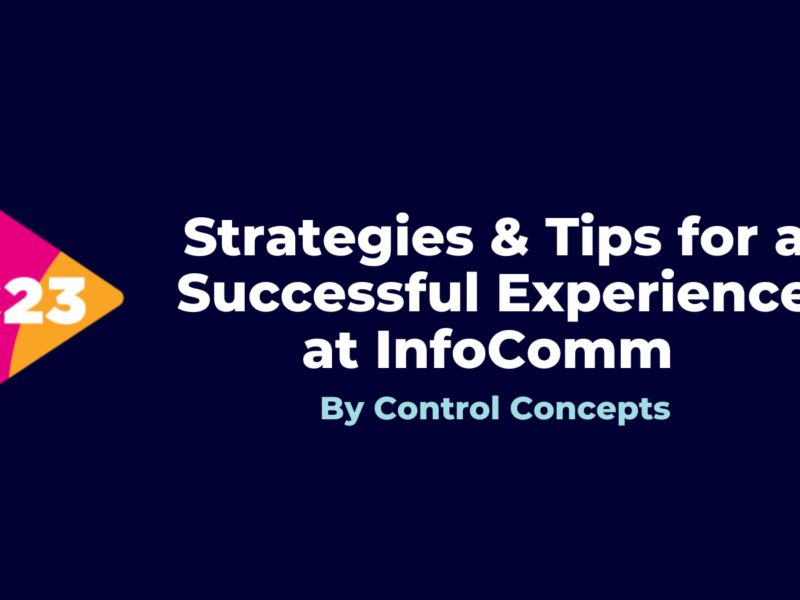
Tried-and-True Wins the AV Heart and Business
Control Concepts’ Steve Greenblatt suggests how client centric strategies can ease AV industry product and labor shortages.
Every industry continues to contend with global business challenges related to product availability(opens in new tab), labor shortage, and rising costs. Clients, service providers, and manufacturers are scrambling to find solutions to address needs within the AV industry and sustain businesses.
Since all manufacturers are dealing with similar challenges to produce and deliver products and all service providers are wrestling with the same extensive equipment delays and staffing issues, the opportunities to gain (or keep) a competitive advantage may come down to the tried-and-true methods of providing personalized and attentive customer service and top-quality support.
Personalized Customer Service
Customer service can be delivered in many ways mostly based on genuine care and empathy for clients. Often a company culture and core values can be demonstrated in the way they interact with their clients on a regular basis. Definitive strategies like frequent communication, transparency of information, timely responsiveness to requests and needs, and client-focused actions are foundational elements that have contributed to the success of many blue-chip organizations. These are also the differentiators that provide a competitive edge between substitutable products and alleviate pricing pressures. It is those firms that pull out all the stops in times of adversity or heightened need to wow their clients, provide an exceptional experience, and do whatever it takes to ensure customer satisfaction that will be remembered and revered.
The luxury retail industry is famous for classic customer service stories where clients’ needs are made the ultimate priority above, not only sales metrics or margin, but at an increased cost of doing business. One such example is an instance where a company could not fulfill the need of a client because they simply did not sell the specific product that was desired. Rather than leaving the client empty-handed or trying to sell the client an alternative, the company personally took the client to their competitor who they knew could satisfy the request. They purchased the product and provided it to the client at no additional cost. Because the relationship was more valuable than the sale, they were even willing to take it back and make it right should the client be dissatisfied.
Recounting another memorable case, a company choosing customer service and client care over self-serving needs. A business was willing to accept a return for an item that was clearly purchased elsewhere and provide the client money out of their pocket. In fact, the product that was returned was way outside the company’s offerings and there was no obligation for them to take it back. Rather than rejecting the client, sending them elsewhere, or potentially creating an undesirable situation, the company opted for the simplicity and convenience of accepting the return and providing a refund the client to demonstrate their desire to provide top level customer service, care, and a commitment to the relationship. In the end, they earned the client’s loyalty and were able to justify the action by maintaining their position as the client’s go to retailer.
[ The Critical Importance of the Ability to Troubleshoot ]
When organizations are focused on putting their clients’ needs first by prioritizing relationships and successful client outcomes over sales volume, profit margin, and winning against competition, they inevitably find greater long-term results leading to unmatched loyalty, and strong client commitment. These are attributes that can only be earned and will far outweigh the benefit of any transaction regardless of size. Additionally, by gaining a client’s trust, pricing and competition become less of a focus in future purchasing decisions and minor hiccups while doing business are more easily forgiven.
Risk and Reward
The strategies that product and service-based businesses can use to be more client-focused run the spectrum of risk tolerance and reward potential. Some fall into the category of minor behavioral changes that are low investment and low risk. Others involve more assertive tactics that are can be costlier or put more at stake. On the extreme end lie the aggressive options that yield the greatest opportunity for value and upside potential yet could come at the most significant cost.
Some of the low investment and easy to implement strategies that organizations can use to build client confidence and commitment include putting a greater focus on actions that demonstrate genuine and personalized care, increased responsiveness, and reduced friction in the customer journey. Through open, honest, and transparent communication that includes frequent status updates of precise information, clients will be armed with the information they need to make effective decisions and increase their probability of success. There are times when this authenticity will result in a client’s decision to pursue other options that are a better fit for their specific, immediate needs; however, in the end, the commitment to being a good partner will be remembered and reflected in the client’s future decision making. Each of these best practices demonstrates a desire to build trust, confidence, and loyalty in a relationship where clients feel that their needs are a priority by being treated as a teammate rather than an adversary.
[ Risk Mitigation Strategies for Evaluating New AV Products During Supply Chain Issues, or Anytime]
In a more assertive move, businesses can pursue collaboration with complementary and competitive organizations to gain fractional wins rather than all or nothing client relationships or sales. Although it would be ideal for a company to get an order for the entire scope of a project, being satisfied with a lesser portion can be a favorable approach. There is a notable quote that states “fifty percent of something is better than one hundred percent of nothing.” By being opened to working together in areas where they may not have done so previously, organizations that suppress their competitive nature and temptation of greed in favor of cooperation and consideration for clients’ benefit will be looked upon favorably. One example of this from an integration perspective is pooling talent with other organizations or piecing together hardware from various sources to deliver a complete, working system to meet a client’s deadline. In another case, manufacturers are demonstrating their interest in making their products easier to integrate and more interoperable from a control standpoint, regardless of competitive boundaries by investing in pre-developed module/drivers/plugins that span a gamut of control system platforms.
On the extreme end, organizations that want to demonstrate the utmost care, consideration, and dedication to their clients’ success will pull out all the stops to ensure that clients’ needs are met by sacrificing time and money to help them succeed. Examples of these strategies include recommending competitors’ products that are viable substitutes to those that they cannot deliver, proactively enlisting the help of competitors in favor of satisfying their clients, and perhaps referring clients to their competitors when they are unable to meet the clients’ needs or provide the desired solution. In all cases where decisions are made to put the clients’ well-being first will not only shine a positive light on the provider, but in true practice of the science of reciprocity, provide future benefit.
Go for the Long-term
By adopting client-centric strategies that are focused on long-term return rather than short-term gains, organizations will find themselves in in better standing once a steady-state in the business climate is restored. Businesses that turn to creative strategies to help satisfy clients’ needs and allow projects to move forward more effectively will build trust and loyalty by demonstrating good nature and selfless consideration resulting in strong bonds that will undoubtedly provide future reward.
(Image credit: Getty Images)
- Post Tags:
- av industry
- business development
- Posted In:
- Media
You might also like
-
Why is it Important to Attend InfoComm? https://controlconcepts.net/wp-content/uploads/2022/04/Copy-of-Strategies-Tips-for-a-Successful-Experience-at-InfoComm23-1024x576.png 1024 576 Steve Greenblatt Steve Greenblatt https://secure.gravatar.com/avatar/2e3b2cb4ec84edcb6983a3711b205d17e3232bf366d96099b3291c500d06f4b2?s=96&d=mm&r=g

-
-




